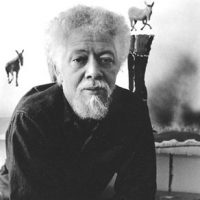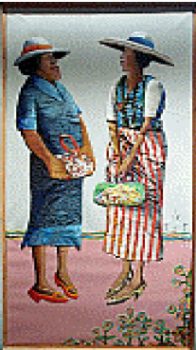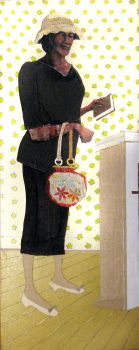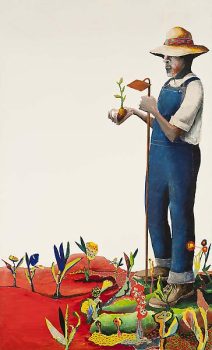

Benny Andrews was born in rural Georgia in 1930. He began his painting practice while studying at the School of the Art Institute of Chicago. After graduating in 1958, he moved to New York City where he continued his work, developing a technique of rough, expressive collage that incorporated cut fabric and paper into his oil paintings. In 1962, the Forum Gallery mounted his first New York solo exhibition. He went on to develop a reputation as a socially-minded artist and an advocate for greater visibility of African Americans in the art world. For the next four decades, he made and exhibited work in New York, and dedicated himself to activism and education in the community.
Andrews continued his prolific output of artwork, which ranged from explorations of history and social justice to intimate depictions of friends and family, until his death in 2006. Throughout his life, he was adamant that to truly effect social change, making art was not enough. He led art education programs for underserved students through Queens College and local community programs, and implemented a groundbreaking model for teaching art in prisons. In 1969, he co-founded the Black Emergency Cultural Coalition, which demanded greater visibility for people of color in art museums and the historical canon. He taught at Queens College through the 1990s, stopping briefly, from 1982 to 1984, to serve as the Director of the Visual Arts program for the National Endowment for the Arts. In his final years, Andrews illustrated children’s books about the lives of Langston Hughes, W. W. Law, Josephine Carroll Smith, and Civil Rights leader Congressman John Lewis. In the foreword to the 2013 exhibition catalog Benny Andrews: There Must Be a Heaven, Lewis remembered Andrews:
“For Benny there was no line where his activism ended, and his art began. To him, using his brush and his pen to capture the essence and spirit of his time was as much an act of protest as sitting-in or sitting-down was for me. I can see him now: thinking, speaking, articulating what needs to be done and in the next few moments trying to make real what he had been contemplating. He was honest to a fault, and I think it was his determination to speak the plain truth that shaped his demand for justice and social integrity. He never aligned with any political group, but would offer the full weight of his support to anyone he thought was standing for truth.”
Website
http://www.bennyandrews.com/




